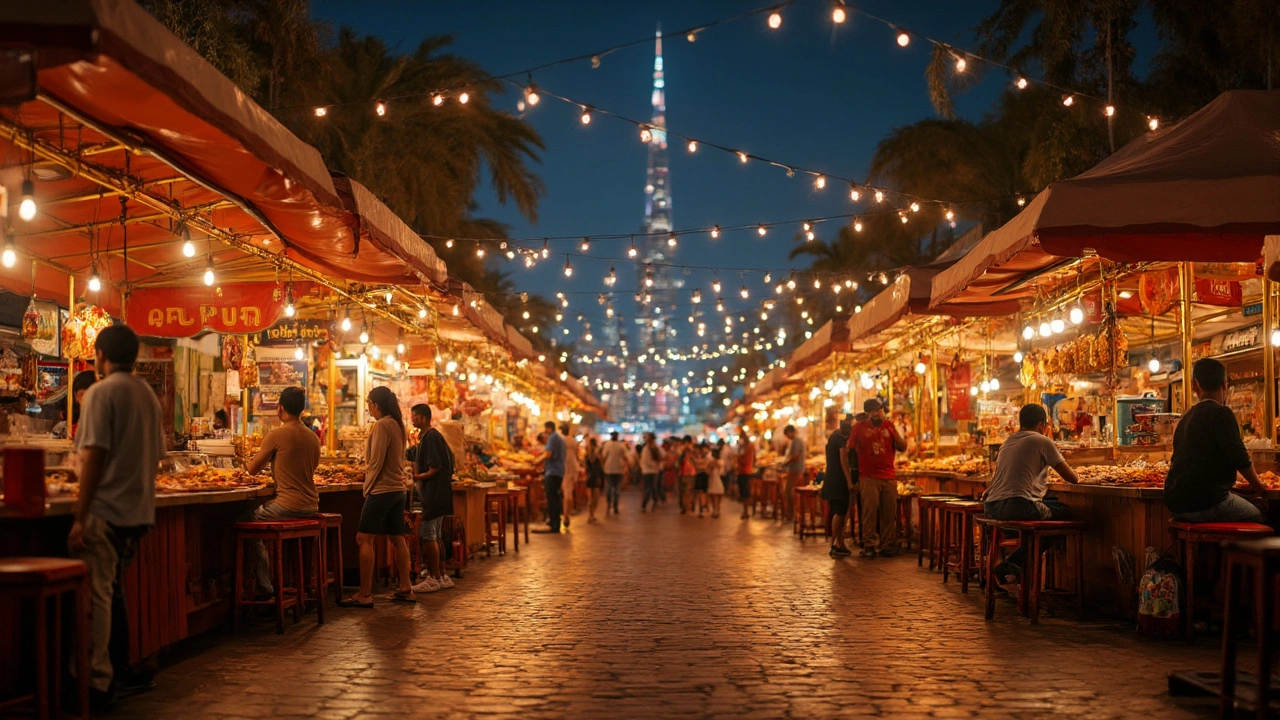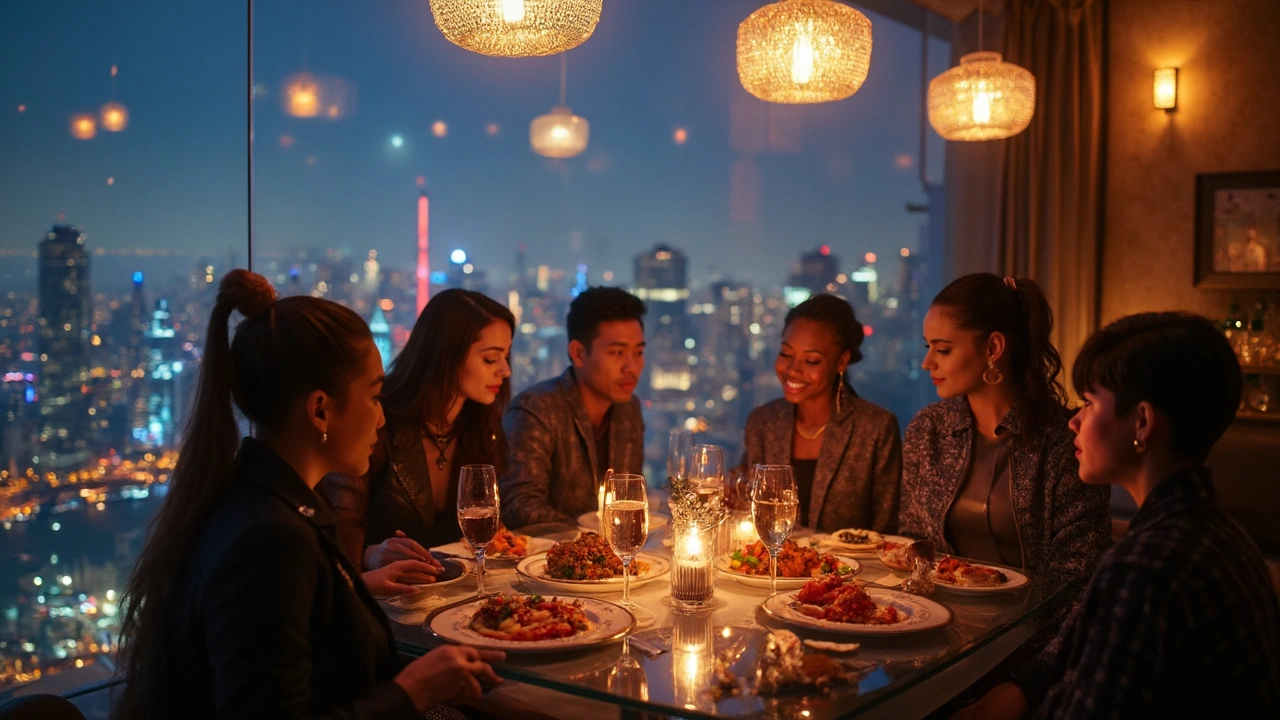
Everybody seems to have a wild story about eating out in Dubai. Some talk about $100 brunches or gold-covered burgers. Others swear they never paid more than a few bucks for an amazing meal in a hidden Pakistani spot. It begs the question: is eating out in Dubai expensive, or is it just a matter of where you look? The answer isn’t as simple as yes or no—Dubai spoils you with endless options, but prices swing dramatically between sky-high luxury and street-food bargains. If you want to unravel the mystery of Dubai’s restaurant prices, grab your curiosity (and maybe your appetite), and let’s dig in.
The Price Spectrum: From Street Eats to Sky-High Splurges
Dubai has a global reputation for luxuries—think Burj Khalifa views, celebrity chefs, and restaurants sitting atop skyscrapers. If you head to places like Zuma, Nobu, or Pierchic, you’ll probably drop 300–700 AED per person (that’s $80–$190 USD) for dinner, easily. A single cocktail at a fancy hotel bar can cost you just under $30. There’s no shortage of record-breaking meals: the world’s most expensive ice cream ($800 at Scoopi Café for a golden sundae), or the legendary $1000 24-karat gold cappuccino at Burj Al Arab. Believe it or not, people do line up for these things as a bucket-list experience. Travel and food magazines eat this up, making Dubai look like a playground for the rich (which, yes, it can be).
But don’t buy into the hype that every plate comes sprinkled with gold. In Deira or Al Karama, you’ll hit bustling cafeterias and ethnic eateries serving aromatic biryanis, manakish, or fresh shawarma wraps. Prices? Often 8–25 AED ($2–$7) for a filling meal. Filipino chains, Indian thali lunch spots, and humble Iranian bakeries are everywhere, serious about flavor and serious about value. Asian tea houses serve spicy noodles and dumplings for $8–$12. It’s not just expats or laborers eating here—the city’s home-grown food scene pulls everyone in.
What makes Dubai unique is that high and low sit side by side. The city runs on diversity; 85% of residents are from somewhere else, so authentic, wallet-friendly international food is non-negotiable. You can spend as much—or as little—as you want. The trick is knowing where and when to look. Local apps like Zomato, Talabat, or The Entertainer help you hunt for solid deals. Most malls and food courts offer a killer mix of global fast-food and indie shops, serving hearty meals for $6–$15.
| Type of Eatery | Average Price per Meal (AED) | Average Price per Meal (USD) |
|---|---|---|
| High-End Fine Dining | 250–700 | 68–190 |
| Hotel Buffet Brunch | 180–550 | 49–150 |
| Casual Mid-Range Restaurant | 70–140 | 19–38 |
| Food Court/Fast Casual | 20–50 | 5–14 |
| Ethnic Cafeteria/Street Eatery | 8–25 | 2–7 |
| Coffee Shop/Latté | 12–25 | 3–6.80 |
This table gives you an honest look at what to expect. Is eating out in Dubai expensive? It can be, but it doesn’t have to be. Your choices (pancake stacks at IHOP, local hummus at Man’oushe, or that gold-dusted burger) define your bill, not Dubai’s zip code.
What Drives Dubai Restaurant Prices?
Why does dinner at a Dubai rooftop cost triple what you’d pay in other cities? Location and view matter, of course. Anything attached to a hotel, luxury development, or waterfront brings a massive markup. The hospitality tax: restaurants inside licensed hotels often pay very high rents and have to source pricey alcohol (no casual BYOB). These costs land squarely on your bill.
The city’s constant drive for the next-big-thing also plays a part. There’s huge fascination with concepts like molecular gastronomy and futuristic presentation—think dry ice clouds, edible flowers, gold leaf, or culinary ‘shows’ at the table. These stunts don’t come cheap. Trendy places have short life spans: today’s must-visit is next year’s old news. Many try to stand out with glitzy interiors, lavish ingredients, or hired celebrity chefs. The price tag reflects the cost of staying relevant in a scene where everyone is gunning for the ‘wow’ factor.
It’s not always about flash, though. The real backbone of Dubai’s food culture is its immigrant workforce—chefs, bakers, cooks from India, Pakistan, Lebanon, the Philippines, Iran, and beyond. Authentic family-style eateries pack flavor, volume, and value. Rent tends to be lower in older districts; employee wages are often modest, so these savings get passed to diners. That’s why certain streets turn into bustling food hubs at lunch, while the glittering tourist spots stay half-empty except on weekends.
Another factor: regulation and taxes. Dubai imposes a tourism fee of 10% (“municipality tax”) on most restaurant bills, with service charges common, especially in hotels. Imported food—everything from leafy greens to American beef—can cost more due to customs charges and logistics. It’s rare for restaurants to use purely local ingredients, since little is grown in the harsh Gulf climate. This pushes up costs for any place aiming for top-tier, global-quality menus.
Let’s zero in on another twist: alcohol. Independent bars hardly exist; drinks are typically served in hotel restaurants only, which limits options and hikes up prices (thanks to expensive licenses). If you want wine with dinner, brace yourself—expect to pay $14–$25 for an average glass, even outside luxury joints. Day-brunches with unlimited drinks have cult status, but the cheapest ones start at 180–220 AED ($50–$60) and range up to $200 for ultra-premium versions.
Dubai loves its theme nights and ‘ladies’ nights’ (offering free drinks and bites for women), plus happy hours with decent half-off drink deals. These are excellent ways to save, especially if you’re hunting for the fun social side and want to keep spending under control.

Budget-Friendly Eats: Where Locals Really Eat
You don’t have to empty your wallet to eat well in Dubai. The best way to experience the city’s food is skipping the glitzy restaurants in favor of neighborhoods and spots that locals love. Explore Deira, Bur Dubai, Al Karama, or Satwa—these are the beating heart of Dubai food, filled with Indian curry houses, Lebanese bakeries, Persian grills, and Filipino fast-food joints. A generous mutton biryani or chicken curry typically runs 12–18 AED ($3–$5) and feeds both your appetite and your sense of adventure.
Shawarma shops are everywhere—juicy spiced chicken, shaved right off the rotisserie, wrapped with garlic sauce and pickles. Usually about 8 AED ($2), it’s Dubai’s real fast food, eaten by students, businessmen, and families alike. Want a classic Arabic breakfast? Grab fresh falafel, hummus, and warm bread from a Palestinian or Syrian café for under 20 AED. Pakistani restaurants offer hearty lentil stews, grilled kebabs, and naan, with meals rarely topping $6 per person.
Don't overlook cafeterias, either. These are Dubai’s answer to greasy spoons: informal, 24/7 spots serving mixed grills, sandwiches, and strong karak chai for pennies. Dine-in might be cramped, but you’ll find workers from every walk of life here. If you’re craving something sweet, try a local bakery’s za'atar manakish or cheese fatayer, both for less than the price of a coffee back home. And yes, you’ll find pizza slices and burgers, too, but the Middle Eastern and Asian specialties are where these joints shine.
Food courts in malls deserve a mention—not all food courts are created equal. Dubai’s have unique offerings: Filipino barbecue skewers, Thai stir-fry, Indian dosas, vegan sushi, Turkish kofte, and yes, mainstream fried chicken or pizza. About 25–40 AED per meal ($7–$11) gets you massive variety, air conditioning, and the chance to try small portions from different stalls.
Don’t be shy about delivery. Apps like Talabat, Deliveroo, and Careem Now are packed with options at every price point. As of 2025, delivery fees average 5–8 AED, so it can be a budget-friendly way to eat a proper meal at home or your hotel. There’s nearly always a promo code floating around.
Cafés selling robust Turkish or Arabic coffee abound. Pull up a stool and order qahwa (spiced Arabic coffee with dates), or try chai karak—a milky, sweet Indian-style tea found at roadside stands night and day. At 1–5 AED (less than $1.50), it’s a little ritual you’ll find locals everywhere enjoying.
- Explore "old Dubai" areas for real bargains (avoid tourist-heavy new developments if you’re on a tight budget).
- Check out lunch specials in business districts—meals are often half the price of dinner.
- Follow food bloggers or Instagrammers for the latest hidden gem recommendations. Dubai’s food scene shifts fast, and social media is the rumor mill.
- Ask locals for their favorites—taxi drivers, hotel clerks, and shopkeepers usually have solid tips.
Tips and Tricks to Stretch Your Dirham
Eating out in Dubai does not have to drain your savings, even if you want a taste of the city’s luxury. The key is timing, location, and a little savvy. Let’s talk practical, concrete hacks for your next meal in the city:
- Use The Entertainer app or website. It’s packed with 2-for-1 offers and deep discounts for restaurants, bars, buffets, and cafés. If you’re with friends or a family, this app alone can slash your dining costs by half everywhere from casual spots to fine dining.
- Happy hours are massive. Most hotel bars and upscale restaurants run deals after work (usually from 5 to 8 pm), where drinks and snacks drop to half price. You don’t have to break the bank for a chic night out.
- Ladies’ nights: if you’re a woman, these are a Dubai institution—free drinks and light bites at dozens of mid-to-high-end bars on certain nights. Check listings before going, as rules shift.
- Look for business lunch menus. Lots of fancy restaurants (think Zuma, La Petite Maison) roll out set lunches during weekdays for 100–150 AED ($27–$41), a fraction of what dinner costs without sacrificing quality or setting.
- Friday brunches are famous, but not always bargain-friendly. If you’re curious but want to save, try a breakfast buffet instead (plenty of 45–85 AED options, or $12–$23, at hotel cafés or mall restaurants).
- Join local Facebook groups or food forums—people post flash deals, tips on happy hours, and last-minute invites to restaurant tastings daily.
- If you crave healthy or vegan food, Dubai offers almost as many budget-friendly options as luxury ones. Chains like Wild & The Moon, Hara Café, and Vietnamese Foodies serve solid, plant-based meals in the 30–55 AED ($8–$15) range.
- Check out theme nights at hotel buffets. Arabian, seafood, steak, or sushi evenings can offer the best value for money with unlimited eats, trending between 120–180 AED ($33–$50) when compared to à la carte menus.
One thing to remember: tipping isn’t strictly required, but it’s appreciated. Service charges of 10% are often included at hotels, but smaller joints may leave it up to you. A couple of dirhams for great service is always welcome.
And here’s a little-known fact: water is rarely free in Dubai restaurants. You’ll almost always be billed for bottled water, $2–$5 a pop. If you’re at a cafeteria or small café, ask specifically for regular water—they might have a free pitcher, or at least cheaper “local” water on the menu.
Bottom line? Eating out in Dubai is as expensive—or as affordable—as you make it. Stick to local favorites and smart tools, and you’ll find there’s no city on earth where you can try more flavors for less.
Post A Comment